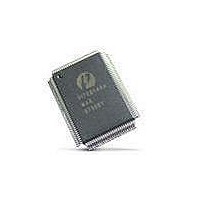PI7C7300DNAE Pericom Semiconductor, PI7C7300DNAE Datasheet - Page 70

PI7C7300DNAE
Manufacturer Part Number
PI7C7300DNAE
Description
IC PCI-PCI BRIDGE 3PORT 272-BGA
Manufacturer
Pericom Semiconductor
Datasheet
1.PI7C7300DNAE.pdf
(107 pages)
Specifications of PI7C7300DNAE
Applications
*
Interface
*
Voltage - Supply
*
Package / Case
272-PBGA
Mounting Type
Surface Mount
Maximum Operating Temperature
+ 85 C
Minimum Operating Temperature
- 40 C
Mounting Style
SMD/SMT
Operating Supply Voltage
3 V to 3.6 V
Supply Current (max)
660 mA
Lead Free Status / RoHS Status
Lead free / RoHS Compliant
Available stocks
Company
Part Number
Manufacturer
Quantity
Price
Company:
Part Number:
PI7C7300DNAE
Manufacturer:
Pericom
Quantity:
135
Company:
Part Number:
PI7C7300DNAE
Manufacturer:
MAX
Quantity:
5 510
10
11
11.1
11.2
Pericom Semiconductor
the secondary bus. If the internal arbiter is disabled, PI7C7300D parks the secondary bus
only when the reconfigured grant signal, S_REQ#[0], is asserted and the secondary bus is
idle.
COMPACT PCI HOT SWAP
Compact PCI (cPCI) Hot Swap (PICMG 2.1, R1.0) defines a process for installing and
removing PCI boards form a Compact PCI system without powering down the system.
The PI7C7300D is Hot Swap Friendly silicon that supports all the cPCI Hot Swap
Capable features and adds support for Software Connection Control. Being Hot Swap
Friendly, the PI7C7300D supports the following:
When the PI7C7300D resides on the Compact PCI add-in card, the Primary Bus must be
the bus that is inserted into the Compact PCI system. To perform the Hot Swap function,
the device must be configured according to the CPCI Hot-Swap Specifications. For the
PI7C7300D, the only path for configuration is through the Primary Bus. The bridge may
not be configured through either secondary buses. If the user chooses to use the
secondary buses for insertion, an external register needs to be provided for the Hot Swap
Control Status Register.
CLOCKS
This chapter provides information about the clocks.
PRIMARY CLOCK INPUTS
PI7C7300D implements a primary clock input for the PCI interface. The primary
interface is synchronized to the primary clock input, P_CLK, and the secondary interface
is synchronized to the secondary clock. The secondary clock is derived internally from
the primary clock, P_CLK, through an internal PLL. PI7C7300D operates at a maximum
frequency of 66 MHz.
SECONDARY CLOCK OUTPUTS
PI7C7300D has 16 secondary clock outputs, S_CLKOUT[15:0] that can be used as clock
inputs for up to fifteen external secondary bus devices. The S_CLKOUT[15:0] outputs
are derived from P_CLK. The secondary clock edges are delayed from P_CLK edges by
a minimum of 0ns. This is the rule for using secondary clocks:
Compliance with PCI Specification 2.2
Tolerates V
Asynchronous Reset
Tolerates Precharge Voltage
I/O Buffers Meet Modified V/I Requirements
Limited I/O Pin Leakage at Precharge Voltage
CC
from Early Power
Page 70 of 107
3-PORT PCI-TO-PCI BRIDGE
November 2005 - Revision 1.01
PI7C7300D












